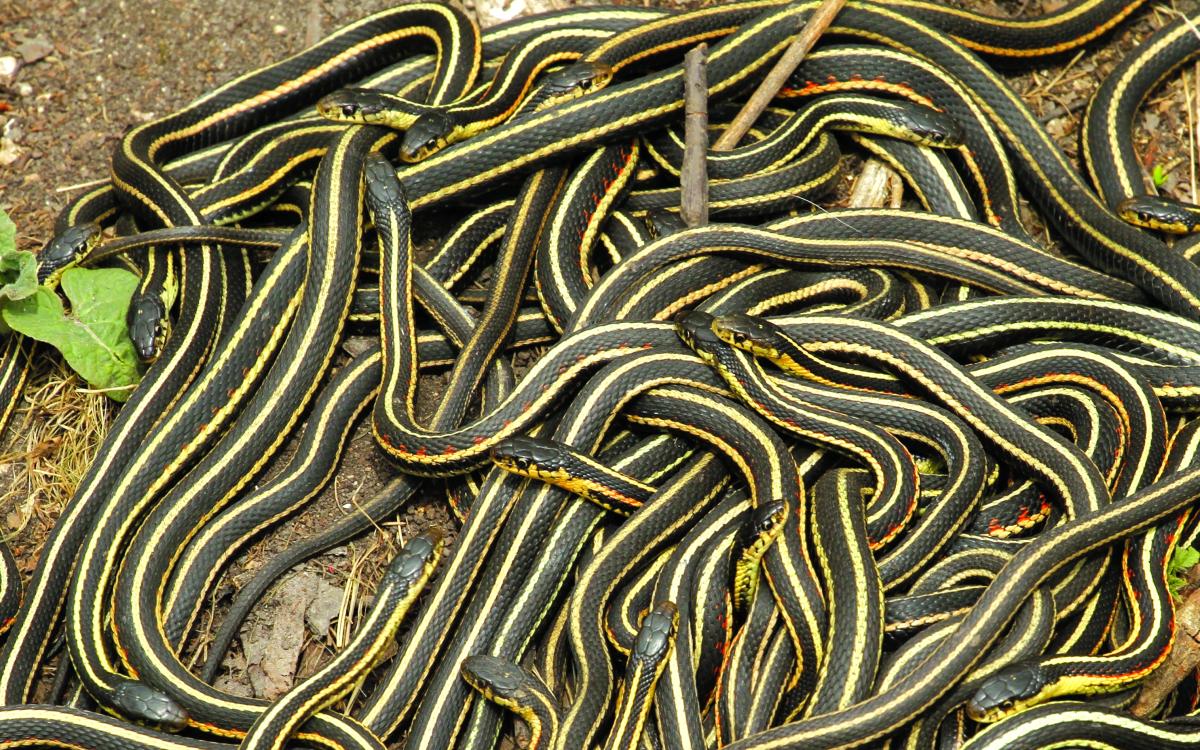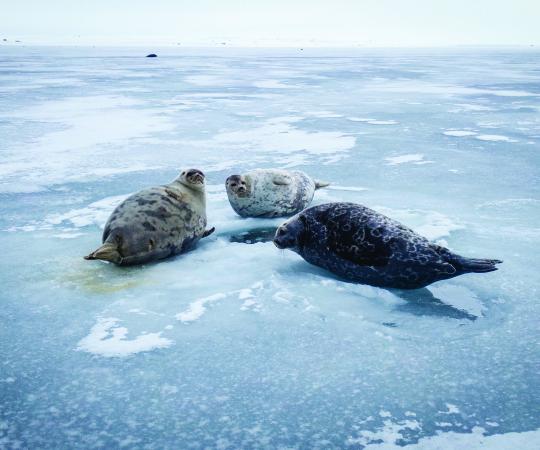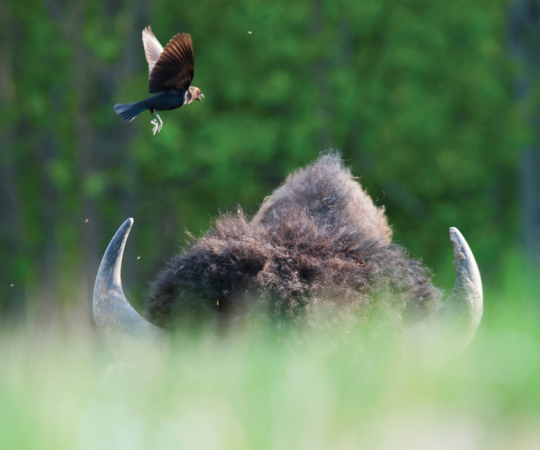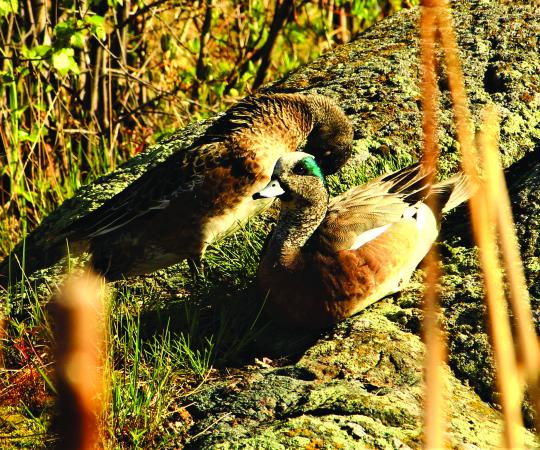The land in and around Wood Buffalo National Park is nothing short of striking: great boreal plain, winding rivers, and vast areas of sand, silt, and salt flats. The land is thick spruce forest, aspen and poplar woodland, and jack pines on the outcrops. Limestone was deposited here in a shallow sea during the Devonian Period some 400 million years ago. It’s now been eroded by water, forming karst topography, multiple channels, and crevices, sinkholes, and caves.
The park, which laps over into the NWT from northern Alberta, is the largest national park in the world and was created to preserve the largest herd of free-roaming wood bison and the nesting area of the endangered whooping crane. Woodland caribou wander the region, feeding on lichens in the forests and sedges, and forbs and grasses on the plains. Several wolf packs hunt the bison, caribou, and increasing numbers of white-tailed deer, as well as smaller prey.
In this mosaic landscape there is a much less noticed but equally fascinating resident that attracts attention during a couple of significant times of the year: the red-sided garter snake. These pretty little snakes (Thamnophis sirtalis parietalis) are the northernmost snakes in North America. They are slender, colourful, and cute, with big round pupils in brown-gold eyes. And they love company, so much so they hibernate together by the thousands in rocky holes.
Garter snakes are common through most of North America and in other parts of the world, but these northern snakes live, literally, on the edge. The NWT is the upper limit of their range. They can survive in the subarctic climate because of the karst landscape.
In August, the snakes begin congregating at hibernacula, holes and fissures in the limestone where they spend their winters. The females enter first, going deep into cracks in the rocks, and huddle in masses of hundreds of snakes below the frost zone, where they literally keep each other warm. (Snakes are cold-blooded, taking on the temperatures of their surroundings, but they do preserve some heat, which the red-sided garter snakes share during their months of hibernation.)
The males enter the hibernaculum a short time later and don’t go quite as deep as the females, hibernating nearer the surface. Everyone settles down for the winter and goes to sleep in mass hugs. Snow drifts into the crevices and collects over the hibernaculum. The insulating properties of snow are such that half a metre of snow means the temperature at ground level under that snow is close to 0°C. The garter snakes, huddled together, can survive several months in the ground.
As temperatures warm in spring, the snow blanket vanishes, and heat begins penetrating the ground. The males, closer to the surface, warm up and make their way out of the hibernacula, usually in early May, about the time the temperatures above the den are in the mid-teens. But they don’t leave right away; they are waiting for the females with great anticipation, as it will soon be time for mating.
As the warmth goes deeper, the females
wake, also in the mood for mating. They make their way to the surface, and a great wonder of springtime starts. At this point, there are literally thousands of snakes emerging from their hibernacula. It’s a rave. The anxious males are waiting; the females are emerging, and everyone’s in the mood for love.
Males throng to the entrances and mob the females, sometimes creating a writhing ball of snakes. Having no hands, snakes require a bit of cooperation to mate. The male aligns himself alongside the female. He has two penises, so it doesn’t matter which side he is on. He curls his tail around the female and deposits sperm in her cloaca and then deposits a plug of mucus, which may prevent her from mating with another male, though this only partly works. The male then goes on to recover and try again. It is a frantic time for the snakes, females pushing out of the den, males pushing to come alongside, with some wrestling and fighting each other to get at the females.
The mating hordes spill out from around the den area into the surrounding terrain, and people come from miles away to see the party. Within a few days, it’s all over and the snakes disperse to their summering ranges, which may be a mile or so from the hibernaculum.
The pregnant females, at this point, are growing the young, which are born in late June or early July. But females can also delay implanting their fertilized ova for a year or longer, until conditions allow the female to safely carry the young. (Northern female populations also seem to be able to delay birth until shortly before hibernation. This ensures their young, which are initially sustained by yolk sacs, go hibernate with considerable internal yolk reserves to survive the winter.)
Garter snakes are ovoviviparous, meaning they produce the young in eggs inside their body. The eggs hatch inside the mother and the young are born alive—tiny, wriggly, active, and independent. They hustle away and, once their yolk sacs are absorbed, they start hunting small prey on their own, including small voles and other mice, hatchlings of ground-nesting birds, insects, snails, leeches, tiny fish, and, further south, earthworms.
In the NWT, a female red-sided garter snake will produce 10 to 12 young, though many don’t survive. Those who do may hibernate the first year away from a mass hibernaculum. If born near the hibernaculum, they will hibernate with the rest, who tend to return in late July and early August, resulting in large gatherings.
Red-sided garter snakes face many dangers. Humans are one of the worst; many snakes are killed trying to cross roads as they are hard to see and easy to hit. Some people, driven by irrational fear, go out of their way to kill them with their vehicles. This is ridiculous. Garter snakes are totally harmless to humans.
Hawks, ravens, owls, foxes, coyotes, mink, and other predators also take many. Drought, meanwhile, dries up the wetlands, killing many of the frogs that are the main prey of red-sided garter snakes.
Another danger, worsening in recent years, is fire. Wood Buffalo National Park and the entire southern NWT has experienced several years of intense wildfires. These little snakes have little hope of evading the flames; intense ground fire kills many. In reality, this threatens the entire population. After the summers of 2023 and 2024, no one knows the impact.
There are only four to six known hibernaculum of the red-sided garter snake in the NWT (there are more in Alberta and Manitoba), so their distribution is limited to south of Great Slave Lake, in Wood Buffalo National Park, and a few other locations such as the Little Buffalo River area, near Hay River and Fort Resolution, and along the south and west shore of Great Slave Lake as far north as the North Arm. (There’s a lot of inaccessible country in between the Mackenzie River and the North Arm, so there may be more unknown hibernacula).
The NWT Species at Risk Committee has categorized the red-sided garter snake as a species of special concern, meaning it is at risk of becoming threatened or endangered. The snakes are relatively protected in Wood Buffalo National Park, but not in other areas. Northerners and visitors can do their part to protect the species by following FireSmart practices and other guidelines to reduce the risk of habitat loss due to forest fires and to avoid killing red-sided garter snakes by driving carefully or, in some cases, learning other ways to deal with unnecessary fears.









